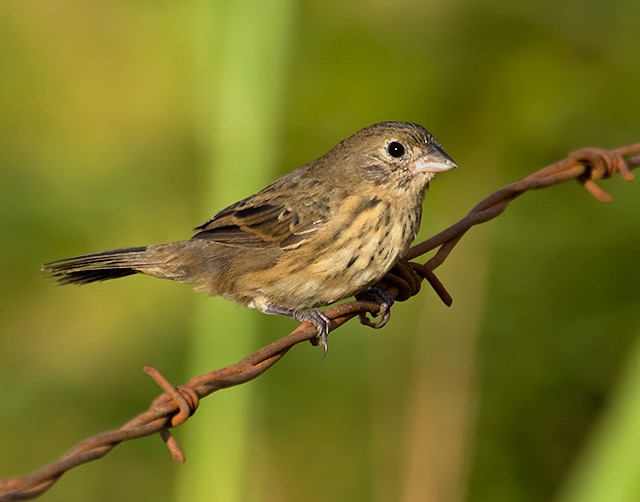Blue-black Grassquit
A species of Blue-black Grassquit Scientific name : Volatinia jacarina Genus : Blue-black Grassquit
Blue-black Grassquit, A species of Blue-black Grassquit
Botanical name: Volatinia jacarina
Genus: Blue-black Grassquit
Content
Description General Info
 Photo By Dario Sanches , used under CC-BY-SA-2.0 /Cropped and compressed from original
Photo By Dario Sanches , used under CC-BY-SA-2.0 /Cropped and compressed from original Description
Adult blue-black grassquits are 10.2 cm (4.0 in) long and weigh 9.3 g (0.33 oz). They have a slender conical black bill. The male is glossy blue-black, with a black tail and wings; the white inner underwing is visible in flight or display. Female and immature birds have brown upperparts and dark-streaked buff underparts. 
Size
11 cm
Colors
Brown
Black
Yellow
White
Blue
Life Expectancy
10 years
Nest Placement
Shrub
Feeding Habits
Blue-black Grassquit primarily feeds on seeds, with foraging activities mostly conducted on the ground. This bird species exhibits no unique dietary adaptations or preferences.
Habitat
The blue-black Grassquit typically inhabits a range of tropical terrestrial environments including savannas, grasslands, and various types of forests such as rainforests and scrub forests. This species favors shrubby weedy fields, open thickets, field edges, and grassy areas near roadsides primarily in the lowlands. Blue-black Grassquit can also be found in marshes, swamps, and utilizing agricultural land. Its habitat extends to mountainous regions, being somewhat less common in foothills, and ranges from sea level up to 2600 meters in altitude.
Dite type
Granivorous
General Info
Feeding Habits
Bird food type
Behavior
Social monogamous, extra-pair fertilizations, intraspecific parasitism, and quasi-parasitism are commonly found. During the breeding season, males defend small territories, about 13,0 - 72,5 m2, dominant males are normally lighter. The male has a jumping display, often performed for long periods, which gives rise to the local name "johnny jump-up". This is accompanied by a persistent wheezing jweeee call, jumping several times in a minute. The extravagant display also has a cost of call attention of predator, thus displays increase the nest predation. Predation are the main cause of breeding failure, and predator vocalizations can cause immune-related reaction to this species. Nests are small cups of rootlets (diameter about 7.5 cm) found at herbaceous vegetation 10–50 cm high, clustered at landscape, and placed preferably at high complex habitat spots. Nests are built by both sexes. Blue-black grassquits will often form flocks when not breeding. They eat seeds, mostly on the ground. 
Species Status
Not globally threatened.
Scientific Classification
Phylum
Chordates Class
Birds Order
Perching birds Family
Tanagers Genus
Blue-black Grassquit Species
Blue-black Grassquit